Potrebujeme váš súhlas na využitie jednotlivých dát, aby sa vám okrem iného mohli ukazovať informácie týkajúce sa vašich záujmov. Súhlas udelíte kliknutím na tlačidlo „OK“.
ASTM E399-12e3
Standard Test Method for Linear-Elastic Plane-Strain Fracture Toughness KIc of Metallic Materials (Includes all amendments And changes 2/6/2018).
Automaticky preložený názov:
Štandardná skúšobná metóda pre Linear-Elastic Plane-Kmeň lomovej húževnatosti ZIS kovových materiálov
NORMA vydaná dňa 15.11.2012
Informácie o norme:
Označenie normy: ASTM E399-12e3
Poznámka: NEPLATNÁ
Dátum vydania normy: 15.11.2012
Kód tovaru: NS-46667
Počet strán: 33
Približná hmotnosť: 99 g (0.22 libier)
Krajina: Americká technická norma
Kategória: Technické normy ASTM
Kategórie - podobné normy:
Anotácia textu normy ASTM E399-12e3 :
Keywords:
ICS Number Code 77.040.10 (Mechanical testing of metals)
Doplňujúce informácie
| Significance and Use | ||||||||||||||||||||||||||||||||||||||||||||||||||||||||||||||||||||||||||||||||||||||||||||||||||||||||||||||||||
|
5.1 The property KIc determined by this test method characterizes the resistance of a material to fracture in a neutral environment in the presence of a sharp crack under essentially linear-elastic stress and severe tensile constraint, such that (1) the state of stress near the crack front approaches tritensile plane strain, and 5.1.1 Variation in the value of KIc can be expected within the allowable range of specimen proportions, 5.1.2 Lower values of KIc can be obtained for materials that fail by cleavage fracture; for example, ferritic steels in the ductile-to-brittle transition region or below, where the crack front length affects the measurement in a stochastic manner independent of crack front constraint. The present test method does not apply to such materials and the user is referred to Test Method E1921 and E1820. Likewise this test method does not apply to high toughness or high tearing-resistance materials whose failure is accompanied by appreciable amounts of plasticity. Guidance on testing elastic-plastic materials is given in Test Method E1820. 5.1.3 The value of KIc obtained by this test method may be used to estimate the relation between failure stress and crack size for a material in service wherein the conditions of high constraint described above would be expected. Background information concerning the basis for development of this test method in terms of linear elastic fracture mechanics may be found in Refs (1) and (3). 5.1.4 Cyclic forces can cause crack extension at KI values less than KIc. Crack extension under cyclic or sustained forces (as by stress corrosion cracking or creep crack growth) can be influenced by temperature and environment. Therefore, when KIc is applied to the design of service components, differences between laboratory test and field conditions shall be considered. 5.1.5 Plane-strain fracture toughness testing is unusual in that there can be no advance assurance that a valid K Ic will be determined in a particular test. Therefore, compliance with the specified validity criteria of this test method is essential. 5.1.6 Residual stresses can adversely affect the indicated KQ and KIc values. The effect can be especially significant for specimens removed from as-heat treated or otherwise non-stress relieved stock, from weldments, from complex wrought parts, or from parts with intentionally induced residual stresses. Indications of residual stress include distortion during specimen machining, results that are specimen configuration dependent, and irregular fatigue precrack growth (either excessive crack front curvature or out-of-plane growth). Guide B909 provides supplementary guidelines for plane strain fracture toughness testing of aluminum alloy products for which complete stress relief is not practicable. Guide B909 includes additional guidelines for recognizing when residual stresses may be significantly biasing test results, methods for minimizing the effects of residual stress during testing, and guidelines for correction and interpretation of data. 5.2 This test method can serve the following purposes: 5.2.1 In research and development, to establish in quantitative terms significant to service performance, the effects of metallurgical variables such as composition or heat treatment, or of fabricating operations such as welding or forming, on the fracture toughness of new or existing materials. 5.2.2 In service evaluation, to establish the suitability of a material for a specific application for which the stress conditions are prescribed and for which maximum flaw sizes can be established with confidence. FIG. 2 Double–Cantilever Clip-In
Displacement Gage Showing Mounting by Means of Integral Knife Edges
(Gage Design Details are Given in Annex A1)
5.2.3 For specifications of acceptance and manufacturing quality control, but only when there is a sound basis for specifying minimum KIc values, and then only if the dimensions of the product are sufficient to provide specimens of the size required for valid KIc determination. The specification of K Ic values in relation to a particular application should signify that a fracture control study has been conducted for the component in relation to the expected loading and environment, and in relation to the sensitivity and reliability of the crack detection procedures that are to be applied prior to service and subsequently during the anticipated life. |
||||||||||||||||||||||||||||||||||||||||||||||||||||||||||||||||||||||||||||||||||||||||||||||||||||||||||||||||||
| 1. Scope | ||||||||||||||||||||||||||||||||||||||||||||||||||||||||||||||||||||||||||||||||||||||||||||||||||||||||||||||||||
|
1.1 This test method covers the determination of fracture toughness (KIc) of metallic materials under predominantly linear-elastic, plane-strain conditions using fatigue precracked specimens having a thickness of 1.6 mm (0.063 in.) or greater2 subjected to slowly, or in special (elective) cases rapidly, increasing crack-displacement force. Details of test apparatus, specimen configuration, and experimental procedure are given in the Annexes. 1.2 This test method is divided into
two parts. The first part gives general recommendations and
requirements for K Ic
testing. The second part consists of Annexes that give specific
information on displacement gage and loading fixture design,
special requirements for individual specimen configurations, and
detailed procedures for fatigue precracking. Additional annexes are
provided that give specific procedures for beryllium and
rapid-force testing.
1.3 General information and requirements common to all specimen configurations:
1.4 Specific requirements related to test apparatus:
1.5 Specific requirements related to individual specimen configurations:
|


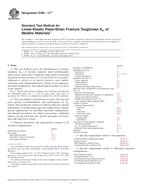
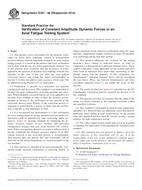 ASTM E467-08(2014)..
ASTM E467-08(2014)..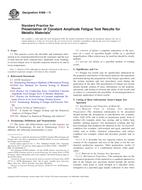 ASTM E468-11
ASTM E468-11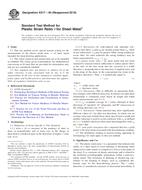 ASTM E517-00(2010)..
ASTM E517-00(2010)..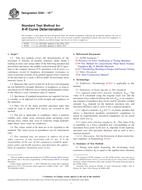 ASTM E561-10e2
ASTM E561-10e2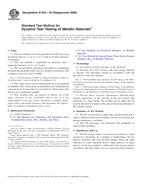 ASTM E604-83(2008)..
ASTM E604-83(2008)..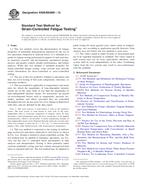 ASTM E606/E606M-12..
ASTM E606/E606M-12..
 Cookies
Cookies
